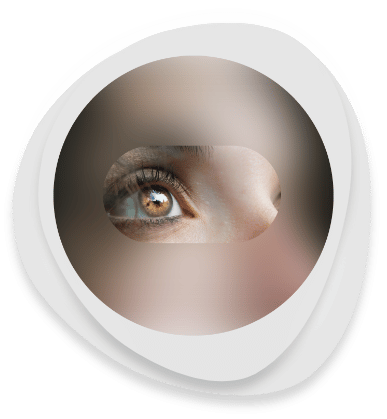January 2024
As we enter our 40s, many of us start to notice that our eyes aren’t quite what they used to be. Suddenly, we find ourselves holding a menu at arm’s length just to read it, and squinting becomes a coping mechanism to bring items into focus. As we age, our eye’s natural lens hardens and becomes less flexible, leading to a slow progression of near vision loss – a condition called presbyopia. As a result, many of our patients in their 40s+ are looking for a way to combat this vision loss, and wonder about LASIK after 40. In this post, we’re going to take a look at whether you can get LASIK after 40 if it’s recommended, and what the pros and cons are. Plus, we’ll cover some alternative treatment options for those who decide it’s not right for them.
LASIK After 40 Concerns & Considerations To Think About
Before we jump into if you can get LASIK after 40 and whether it’s recommended, there are some concerns and considerations that need to be brought up first.
- After 40, the benefits of LASIK for near vision may only last a few years before presbyopia sets in (monovision can treat this). Distance vision should remain good. This is not “LASIK wearing off” but rather the result of the natural aging process causing your own lens to lose flexibility. Without that lens flexibility, the eye can’t pull the focus from distant objects to those at close range.
- Older adults may have a higher risk of developing age-related eye conditions that can impact the outcome of their LASIK treatment (cataracts, glaucoma, presbyopia). LASIK doesn’t cause these issues, but it can’t prevent them either.
- LASIK after 40 may not work well in patients who have other health conditions present like dry eyes, diabetes, or autoimmune disorders. The doctors at OVO will help screen you for your eligibility for surgery and treat any underlying conditions that may exist.
However, this doesn’t mean that LASIK after 40 years old isn’t worth getting or isn’t an option! The best way to find out if LASIK will work with you is to book a consultation at OVO to determine if you’re a good candidate for LASIK or Monovision LASIK. Plus, if you’re not a good candidate, there are plenty of alternative treatment options, which we list below.
What Is Monovision LASIK?
Monovision LASIK is a laser vision correction procedure that corrects one eye for distance vision and the other for near vision, unlike traditional LASIK which corrects both eyes for clear distance vision. Monovision LASIK after 40 years old is an option for those experiencing presbyopia, as it can provide patients with both distance and near vision without the need for glasses or contacts. Monovision LASIK is best suited for those who have previously adapted to monovision using contact lenses and have a compatible lifestyle and visual needs. With monovision, distance vision is good, and near vision is good, but not as “perfect” as when both eyes are focused at the same distance. When very crisp vision is needed, contacts or glasses can be used which bring both eyes into the same focal plane.
The Pros Of Getting LASIK Eye Surgery After 40
The benefits of going through with LASIK eye surgery include:
1. Find New-found Freedom, Flexibility, & Independence. Many people who undergo LASIK eye surgery after 40 report feeling a sense of newfound freedom, flexibility, and independence. This is because LASIK can significantly reduce or even eliminate their dependence on glasses or contact lenses. After LASIK, patients can enjoy activities like swimming, playing sports, and traveling without worrying about their vision. In addition, the convenience of not having to wear glasses or contacts can improve one’s self-confidence and overall quality of life.
LASIK Works Across a Number of Circumstances. LASIK does work over 40 in a variety of circumstances. For example:
a. Someone with nearsightedness and mild astigmatism can have their refractive errors corrected with LASIK after 40. They may opt for extremely sharp distance vision in both eyes and choose over-the-counter reading glasses for near tasks.
b. An individual with great distance vision but poor near-vision, who wants to do away with reading glasses, can have it corrected with LASIK monovision.
c. An individual with excellent near vision, who wants their moderate nearsightedness corrected, could choose Monovision LASIK.
2. Monovision LASIK Tackles Presbyopia & Is Reversible. If you have age-related presbyopia, you may automatically think you’re disqualified from LASIK, but that’s simply not true. Monovision LASIK after 40 is a good option for patients who want to correct their eyesight for both distance and near vision loss, and the best part is that it’s reversible. If a patient doesn’t like the results, the procedure is reversed by performing LASIK on the under-corrected eye for distance vision. It can take a bit of time to get used to Monovision, but the vast majority of patients do well with it.
The Cons of Getting LASIK Eye Surgery After 40
While the benefits of LASIK after 40 include clear vision, ditching those reading glasses, and new-found freedom, it does have some downsides like any medical procedure.
- Natural Deterioration Still Occurs. Even with LASIK or Monovision LASIK, the natural deterioration of your eyes as you continue to age into your 50-60s is still going to happen. This may result in you eventually needing reading glasses or bifocals, depending on how quickly your eyes deteriorate.
- You May Not Adjust to Monovision. If you have presbyopia and choose the Monovision LASIK option, you may not adjust to how your new vision works. We highly recommend that those interested in LASIK after 40, select Monovision-based contact lenses (temporary solution) to see how they like Monovision before going ahead with LASIK.
- Monovision LASIK is a Compromise. With Monovision LASIK, you gain greater convenience and more freedom from glasses but you won’t necessarily have perfect distance vision or perfect close-up vision – it’s a compromise. You may notice that your depth perception is slightly decreased, especially in low-light conditions (dimly lit restaurants) or during activities that require sharp vision (sports). Some patients will opt to wear a single contact lens during sports, bringing their reading eye to distance just for that event.
- You May Grapple With Dry Eyes. A common side effect of LASIK is dry eyes, which do clear up in 3-6-months. But in those over 40, who may be more prone to dry eye syndrome, this healing process may take longer or be more problematic to deal with (longer use of eye drops needed, more follow-up appointments, etc.).
- Night Vision Disturbances. While not specific to those aged 40+, if you’re someone who prefers to travel at night, whether that be for work or vacation, then reduced night vision may be a con. A potential side effect of LASIK is an increase in glares, halos, and reduced vision at night, which can make low-light conditions difficult to travel in. Fortunately, OVO develops and uses the very latest LASIK technologies, such as Contoura Topography-Guided LASIK, which can reduce the chance of glare, halo, and difficulty driving at night.
- Later Life Consideration: Cataracts. If there is a history of cataracts in your family, you’re diabetic, or you already have cataracts, then LASIK may not be the right option for you. In these cases, it may be better to improve your vision using lens-based surgeries. Our name is OVO LASIK + LENS for a reason, we excel at both! In addition to this, because LASIK changes the shape of your cornea, if you do develop cataracts later on in life, this cornea alternation may make it more difficult to determine the correct cataract IOL prescription for you. But don’t worry, OVO has you covered there as well. We offer light adaptable lenses from RxSight that can be altered after implantation to ensure the refractive target is exactly what the patient wants.
- Your eye may still change, meaning your refractive error might change. LASIK reshapes the cornea. While the cornea tends to remain stable after LASIK, other parts of your eye may change with time. If your lens changes and becomes a cataract, your vision may change and your refraction may change as well.
Is It Worth Getting LASIK After 40: How To Decide If It’s Right For You
Is it worth getting LASIK after 40? For many patients, it is very much worthwhile. While it’s true that LASIK is not suitable for everyone, especially those with other age-related eye conditions, it doesn’t mean that it’s off the table. LASIK is transformative, and could be right for you if:
- Your current eye prescription and vision goals can be corrected with LASIK, and you are okay with wearing reading glasses when presbyopia does set in.
- You have a good medical history with no major eye health problems.
- You have realistic expectations of what LASIK can do for you, and you’re willing to follow post-operative instructions carefully and attend regular follow-up visits to monitor the healing process.
- Likewise, you understand that LASIK does come with possible risks and side effects and that your vision may change over time due to age-related conditions or factors.
To decide if LASIK is worth it after 40, we recommend a consultation with one of our experienced doctors, who will evaluate your eyes and recommend the best course of action for your vision needs. If LASIK is not the recommended course of action, then we do have some alternative options that may work better for you.
4 Alternative Surgical Options to LASIK After 40
In some cases, LASIK after 40 may not be the best option for improving vision. Alternative options may include:
- PRK (Photorefractive Keratectomy): A similar procedure to LASIK that reshapes the cornea using a laser, to improve how light rays are focused onto the retina. PRK is performed to treat refractive errors in the eyes, including myopia, hyperopia, and astigmatism. Unlike LASIK, PRK does not involve cutting a flap in the cornea, making it ideal for people with dry eyes, thin corneas, or an active lifestyle. PRK requires a longer recovery period and can cause more discomfort than LASIK, but long-term vision quality is comparable.
- Restorative Lens Exchange (RLE) is a surgical procedure that replaces the natural lens of the eye with an artificial intraocular lens (IOL) to improve vision. It’s an alternative to LASIK for patients over 40. RLE can correct nearsightedness, farsightedness, and astigmatism, and can also address presbyopia, a condition that makes it difficult to focus on close objects. While LASIK reshapes the cornea, RLE replaces the natural lens, providing a permanent solution to vision problems. As an added benefit, these patients will not get cataracts later in life.
- Phakic intraocular lens (ICL EVO) implants are a type of vision correction surgery that involves placing a small lens inside the eye to improve vision. This can be a good alternative for people over 40 who have age-related changes in their eyes that make LASIK less effective. Phakic IOLs can improve nearsightedness, farsightedness, and astigmatism, and they can be removed or replaced if necessary.
It is important to discuss all options with an eye doctor to determine the best course of action for improving vision.
Conclusion
If you’re over the age of 40 and looking to improve your vision while reducing your dependence on glasses or contact lenses, LASIK eye surgery after 40 is definitely an option worth considering. It is highly recommended that you have an in-depth discussion with one of our qualified LASIK surgeons to explore all available treatment options. Here at OVO LASIK + Lens, we offer free, in-depth LASIK exams to all patients considering LASIK, and we would love to guide you through our process, our state-of-the-art technology, and answer any questions you may have to determine if LASIK is the right option for you. Contact us today to schedule your free LASIK exam and take your first step towards clear, crisp vision.
NEWS + PRESS
Schedule Your Free OVO Lasik
Consultation Today!

We’ll never share your details.






